Landscapes
beach, canon 7d, cape cod, cape cod bay, clouds, color, EF 17-40mm f/4L USM, film, fuji velvia 50, golden hour, mamiya 7, massachusets, ocean, sky, smartphone, sunset, tools, velvia suadb
9:14 pm
This past summer, I had the opportunity to visit Cape Cod, Massachusetts for the first time. It’s a place of quiet fishing villages, trendy tourist destinations and hip hangouts. Since it’s a peninsula, it’s also a very convenient destination for both sunrise and sunset photography – on multiple days, I was able to shoot both golden hours.
In this post, I present three shots taken within moments of each other, with three different cameras. It was a sunset shoot at Rock Harbor, not far from the city of Orleans, MA. The extremely low tide left many tidal pools and exposed sand dunes and grass patches, so there were plenty of ways to experiment with composition.
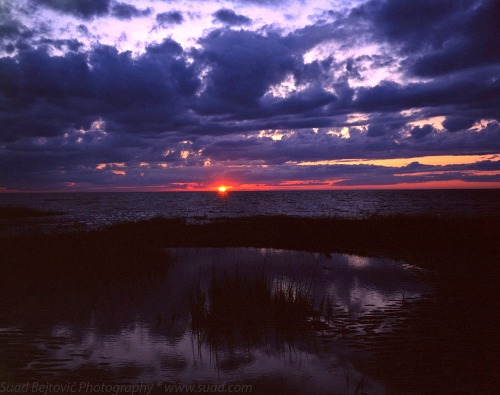
Rock Harbor Sunset, Film Camera
First up is my massively reliable medium format camera, Mamiya 7, which was loaded with the legendary Fuji Velvia 50 film. The metering for a sunset scene is never easy, and for a contrasty film like Velvia, I wanted to preserve the highlights, but the shot still ended up quite underexposed — most of the foreground is just too dark. On the other hand, the setting sun and the sky at the horizon have a great color to it, and I love the dark fluffy clouds on top set against the still bright sky. The composition of the foreground is also pleasing, with the patch of grass in the tidal pool. As usual for a shot done on Velvia, I didn’t do much post-processing; I tried to improve the shadows a bit, but not to the point where the photo becomes too grainy.
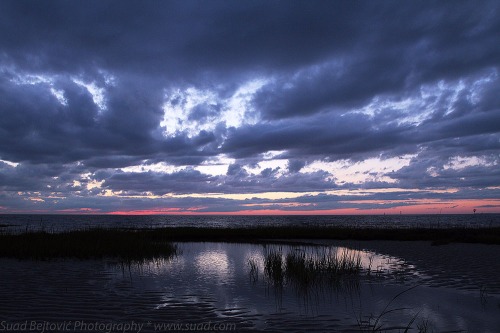
Rock Harbor Sunset, Digital SLR Camera
A few moments later, the sun finally set, but the sky was still pretty bright. This shot was taken by my digital camera, Canon 7D, at the widest setting on my 17-40mm f/4L lens. The composition seems a little different, lower to the ground, and the horizon falls closer to the rule of thirds. The bluish tint is typical for the “blue hour”, but there is still some reddish hues to add interest to the shot. As in the film shot, the tidal pool provides a great reflection, and I like the ripples in the sand, too. I would have liked some more color in the photo, but it still has a nice moody quality – of the three shots, it would probably work the best in black and white. And speaking of quality, even at ISO 800, there is almost no noise or grain in the image.
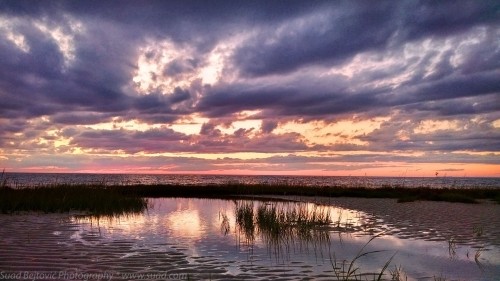
Rock Harbor Sunset, Smartphone Camera
Finally, we have the humble smartphone camera; I had with me the Droid Ultra and its 10 megapixel camera, which is more than decent. I metered for the brightest part of the image and let the automatic settings fall where they may. As it happens, I like this shot the best, and it’s partly because of the very wide native format of the camera, which works well with the scene. It’s also very bright, but nothing seems too blown out. There is some chrominance noise in the clouds, but other than that, the shot looks very sharp and clean. I posted it on my Instagram page in its cropped form.
In the end, no one shot is significantly better than the others, but this exercise helps me compare how different cameras see the same scene, so that I can use them more efficiently next time.
Leave a Response »
Landscapes
Bryce Canyon, bryce canyon national park, canon 7d, film, fuji velvia 50, golden hour, hoodoo, long exposure, mamiya 7, medium format, night, night photography, rock, rocks, sedimentary rock, sunrise, thor's hammer, utah, velvia suadb
8:46 am
In my previous post from the Bryce Canyon National Park, I mentioned a rock formation known as Thor’s Hammer. It is one of the countless “hoodoos” in the main amphitheater of the park, but possibly the most imposing and easily recognizable.

Thor’s Hammer, Bryce Canyon National Park
It gets its name from the shape at the top of the spire; through some fortunate geological coincidence, the sedimentary rock at the top of the spire is harder than the one below it, so it eroded less over eons, resulting in the characteristic shape. The rock is porous and the water that seeps in the microscopic cracks expands and contracts during endless daily freeze-thaw cycles, carving stone into hoodoos in the process. Geology meets mythology, you might say.
To get this photo, I simply walked down the path just under the Sunset point. It’s about as close as you can get to the Hammer, as it sticks out from the slope of the canyon. The rising June sun paints it a bright orange color while most of the rest of the amphitheater is still lit indirectly. One thing I love about the amphitheater is the shades of orange and red that it creates as light bounces around in the tight spaces in between the hoodoos.
It seems like Hammer has three siblings who live next door, but they are bunched together, and we’ll see over the next few millenia whether they turn into something quite as imposing as the Hammer. Who knows, maybe by that time the endless freeze-thaw cycles of Bryce Canyon would end Thor’s Hammer as we see it today.

Thor’s Hammer At Night
As it happens, I walked this path around midnight the previous night. The Moon was full and high up in the summer sky and it lit the amphitheater beautifully. There were even guided midnight hiking tours, where visitors got to see a very different Bryce Canyon. I took several digital shots, and was reminded of an old technical problem; without a remote shutter release, I could only take 30-second exposures, unless I wanted to hold my finger on the shutter button for an extended period of time. On top of that, I had to use a pretty narrow f/11 aperture setting, to keep everything sharp, since camera has a hard time getting focus lock in such low light conditions. As a result, I bumped the ISO on my Canon 7D camera to 1600, but it all worked out nicely — photo is sharp and not too noisy, and offers a different perspective of this great looking rock.
Leave a Response »
Landscapes
bryce canyon national park, film, formula, fuji velvia 50, golden hour, hiking, hoodoo, mamiya 7, medium format, national park, rock, rocks, Sentinel, sunrise, utah, velvia suadb
8:16 am
Bryce Canyon National Park is one of my favorite places to watch the sunrise. It’s more of an amphitheater than a canyon, and it’s facing east, so the morning sun lights up the endless rock formations known as hoodoos. The resulting color palette is a sight to behold.
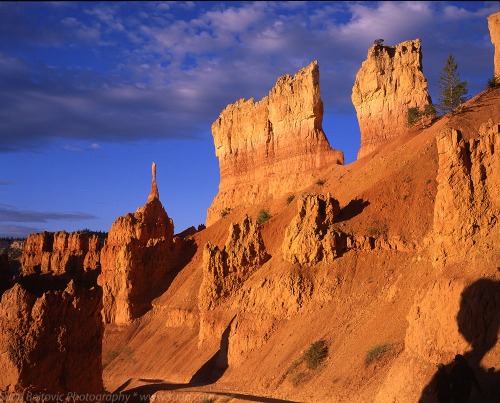
Sentinel, Bryce Canyon National Park
I shot sunrise at Bryce on two separate earlier trips, but when I decided to attend a conference in Las Vegas in June 2013, I knew I would want to do it again. And so, after the conference wrapped up, I rented a car, and made the 4-or-so-hour drive into the mountains of Utah.
I stayed only two nights, which meant two attempts at a sunrise. The first morning I stayed at the rim and shot pretty much the same composition as I did a few years ago. As it happens, that’s been one of my most successful photos ever, so I didn’t improve on it.
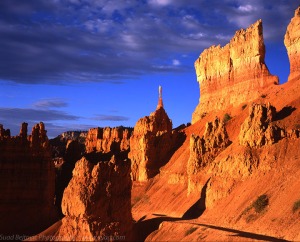
Sentinel, Without the Hikers
The second morning I decided to walk down the trail and among the hoodoos. The shot was set up so that the Thor’s Hammer, a famous rock formation, was behind me. In front of me was the slender spire called The Sentinel, and some rock cliffs on the right. The horizon to the east was muddled with some clouds, but in a fortuitous moment, the sun shone through and lit the cliffs perfectly.

Sentinel, Without the Sunlight
As it would turn out, in that fortuitous moment, two hikers leisurely walked into the bottom right corner of my frame. Since my Mamiya 7 is a rangefinder camera, I didn’t notice them through the viewfinder, but the lens definitely did, since it sits down and to the right from the viewfinder. I didn’t feel like editing them out until I’m ready to display the photo at an exhibit or something, so I took another shot, shown here in the smaller format. The composition isn’t quite what I’d like, but the colors are still spectacular. In fact, they look even more saturated here due to the fact that I scanned that frame with a little less care than the main photo above.
Another bonus shot is of the same composition, taken while the sun was obscured by the clouds. It’s just another proof of my “Formula” for a successful shot, which states that you need only Fuji Velvia 50 film and “golden hour” sunlight; the subject almost doesn’t matter. Here’s the same subject under two lighting conditions only moments apart, and while it looks nice on one shot, it really comes alive in the other.
Leave a Response »
Landscapes
bush key, canon 7d, civil war, digital camera, dry tortugas, EF 17-40mm f/4L USM, EF 85mm f/1.8 USM, film, florida, fort jefferson, fortress, garden key, key west, mamiya 7, moat, national park, photography, rodman gun, rodman rifle, samuel mudd, velvia, velvia 50 suadb
1:30 pm

Entrance to Fort Jefferson
Although I’m a big fan of the National Park Service, I never even heard of the Dry Tortugas National Park until I visited Key West, Florida in December 2012. It’s an ecological paradise, sanctuary to countless species of birds and marine life. The only catch is that it’s located 90 miles to the west of Key West, which makes it one of the more difficult National Parks to get to.
Nevertheless, a few photos on a brochure I looked at convinced me that the trip is well worth taking. My hotel made arrangements with the speedy boat to take me there early one morning. The ride is a couple of hours long and on this particular trip the sea was quite choppy, so some passengers lost their breakfast before they got to the destination.

Fort Jefferson – looking over the moat to the Loggerhead Key in the distance (film shot)
When we finally docked at Garden Key, we were greeted by the massive Fort Jefferson, built in the 19th century to provide a strategic stronghold in the Gulf of Mexico. Wikipedia says that it’s a largest masonry structure in the Americas, consisting of 16 million bricks. It even has a moat built around it, with a walkway that circumnavigates the fort.

Rodman Gun, Fort Jefferson
The fort was fully operational during the Civil War and it included a prison, whose most famous inmate was Dr. Samuel Mudd, serving the sentence for treating the broken leg of John Wilkes Booth following his assassination of President Lincoln. Mudd ended up serving as the fort doctor during the outbreak of the yellow fever in 1867, which in part led to his pardon.
Civil War history of the fort is also evident by several heavy cannons that can still be found around it. Pictured above is a 10-inch Rodman gun, one of the most common in the fort.

Fort Jefferson, View from Bush Key
Finally, since the tide was pretty low, I decided to walk across a small sandbar onto the Bush Key, which appears as a separate island on most photos I’ve seen, because the sandbar gets submerged. Looking back to Fort Jefferson, you can see on the left the catamaran ship that brought me there, and the seaplane which originated in Alaska judging from the tail insignia.
Bush Key walk was thoroughly enjoyable and I made some nice photographs that I will share in a separate post.
Leave a Response »
365 Project and Landscapes
agathla, arizona, canon, canon 20d, canon 20d digital camera, digital, erosion, film, fuji velvia 50, monument valley, moonlight, night, peak, rock, shutter release, sunset, travel, utah, vacation, velvia, volcanic plug, volcano suadb
10:52 pm
When I decided to start the 365 project, I realized I will have to recycle some of the photos I have been posting over the last 5 or so years on my Flickr page. The tougher challenge would have been to actually post a brand new photo every day for a year – and that may be something I can look into next year.
I balance that by often posting more than one photo in each blog post. So, today, I wanted to share three photos from one of the most surprisingly magical places I visited.

Agathla Peak, After Sunset (digital)
This is Agathla Peak, sometimes called El Capitan, and it is a volcanic plug just south of the border between Utah and Arizona. My friends John, Tyler and I were on our way to the Monument Valley a few years ago and couldn’t help seeing this fantastic piece of rock protruding from the ground.
After shooting a sunset at the Monument Valley, we stopped by Agathla on our way back to Page, AZ. That’s where the first photo was made – I made it with my Canon 20D digital camera. Because I didn’t have a remote shutter release, I had to limit the exposure to 30 seconds, using the ISO of 400 and even lightening the photo in post-processing.

Agathla Peak, Day (film)
A year later, the three of us were joined by our friend and photographer Scott; this time Agathla wasn’t going to surprise us. We made sure to have enough time to stop there in the afternoon. The second photo was shot on medium format Velvia 50 film, and you see it here pretty much the way it looks like on the slide. I was very proud of it – the composition was great and the moment captured was lovely. Just look at those clouds!

Agathla Peak, Night (digital)
Speaking of clouds, the third photo was taken later that night; the wind was moving the clouds exactly over the tip of Agathla, which became very evident on this 5-minute exposure. That’s no typo – this shot is lit by nothing except the Moon, and it took 5 minutes to get enough light to the camera sensor. You can even see the star trails – that’s how much the stars moved while the photo was being taken. You can tell I was ready to take this photo by the fact that I bought a remote shutter release for my Canon 20D.
Don’t let this rather technical post diminish the fact that this place is just fantastic. It’s nothing but a rock sticking out of the ground, but the combination of its ruggedness and the relative serenity of its immediate surroundings creates a very dramatic image, at any time of day. Or night.
Leave a Response »
Landscapes
beach, black and white, film, first beach, forks, fuji velvia 50, fuji velvia film, hugh laurie, ilford delta 100, la push, let them talk, mamiya, mamiya 7, medium format camera, national park, olympic national park, outdoors, pacific, Pacific Northwest, second beach, travel, twilight, velvia, washington suadb
2:27 am
As I mentioned before, in August 2011 I visited my friend and photographer Tyler in Seattle. He was kind enough to provide me with a tour of nearby National Parks, which he documented quite well over the last few years since he moved into the area.
One day, I’ll tell you a sad story about a very nice sunrise at Mount Rainier, but this story, far less sad, begins later that same day.
After breakfast at Rainier, we broke camp and took a few hours drive west to a quaint little town of Forks, WA, made famous by some teenage vampire novels you may have heard of. We stopped at a few places along the way and took some photos, but the main goal was to get to the Second Beach, a secluded place on the western side of the Olympic peninsula, in time for the sunset.

Third Beach, Olympic National Park, Washington
And we did, or so we thought. The First, Second and Third beaches are adjacent lagoons, each with its own trail leading back to the main road to La Push, WA. But, since it was an afternoon of a long day when we drove by, we didn’t realize we took the trail for the Third beach until we hit the sand, a mile or so later.

Twilight-themed signs at a restaurant in Forks, WA
Which was just as well, because it was a perfectly lovely place, and the dying light of the day provided great back lighting to the distant sea stacks. I started a new roll of Fuji Velvia film with two sunset shots, of which I prefer this one, with more dramatic clouds and nice reflection in the water. I wish I had a longer lens than the normal 80mm on my Mamiya 7 medium format camera, or that I were closer to the distant sea stacks, but it still ended up being a very nice photo.
We went back among the werewolves and vampires (see phone camera photo), regrouped and tried again in the morning to find the Second beach. When we got there, I saw why Tyler wanted us to go there in the first place. Massive sea stacks dominated the landscape, and an extremely low tide revealed many of the smaller rocks, and billions of muscle shells clinging on to the rock.

Second Beach, Olympic National Park, Washington
Spoiling the fun were the Pacific Northwest clouds which obscured the rising sun. We still tried to make the best of it and trotted around the beach and among the rocks, and made a few photos along the way. I changed films from the high-contrast Fuji Velvia to the lower contrast Ilford Delta 100. The overcast sky and the lingering fog gave the scene a moody feeling, which I ended up enjoying.
Although remote, Olympic National Park is well worth the trip – in this post, I didn’t even mention the central part of the park with rainforests, river valleys and dramatic waterfalls, like the Sol Duc Falls. By the time we got back to civilization, the weather cleared up very nicely. As a bonus from the visit, during our stop at a Starbucks I ended up picking up Hugh Laurie’s excellent CD “Let Them Talk“, which I like almost as much as these photos.
Leave a Response »
Landscapes
Babanovac, black and white, Bosnia, Bosnia and Herzegovina, film, golden hour, Herzegovina, HP5, ilford, mamiya, medium format, mountain, resort, sunset, travel, vacation, velvia, Vlasic suadb
7:52 pm
In October of this year, as I try to do every year, I visited my homeland of Bosnia and Herzegovina and spent two weeks with the closest members of my family – mom, dad, and sister. The four of us wanted to take an extended weekend trip to a resort on the mountain of Vlašić, a few hours north of the home town and capital of Sarajevo. All photos in this post were taken with my new medium format film camera, Mamiya 7.
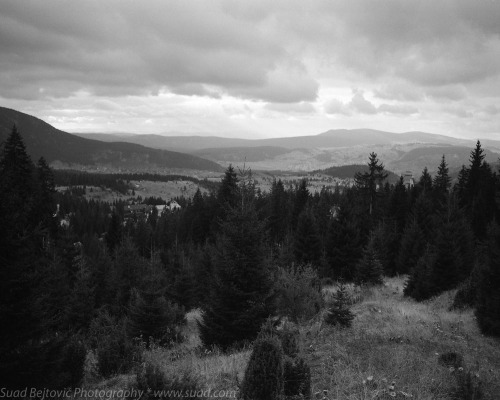
Clouds over a Valley
To properly write “Vlašić” is hard enough with English alphabet, and to pronounce it even harder. But the place is a gorgeous ski resort, which we visited before the first snow and the official start of the busy season. The black and white photo above (Ilford HP5 film) was one of the first I took up there, on a trail just above a ski jump tower, which can be seen above the tree canopies on the right. The sky was quite foreboding and threatened the sleepy valley below.
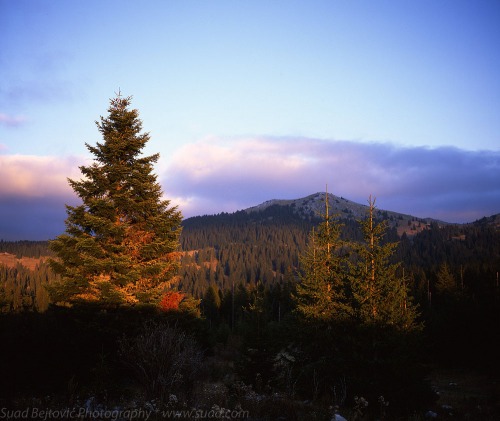
Last Light on Pines
The following morning, I was too lazy to get up and shoot the sunrise, but in the evening, I went back up the trail to try to catch some of the warm “golden hour” light. The clouds parted a bit and just before the sun went down, it lit beautifully this row of conifer trees. I like the way that streak of red stands out among the green, both of which come out great on the Fuji Velvia film.
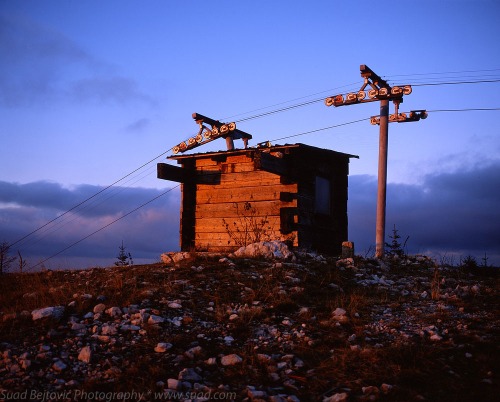
Ski Lift Shack
Remarkably, I managed to squeeze one more shot during this golden hour – the odd looking building is a tiny wooden shack at the top of the ski lift. The wood picks up the warm light nicely, enhanced again by the magical Fuji Velvia.
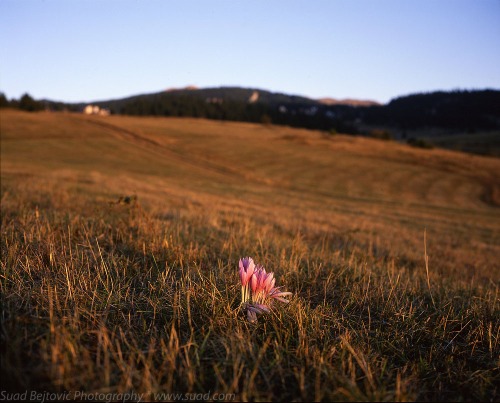
Splash of Color
A day or two later, on our last evening on the mountain, I went for a walk in a different direction – not as much elevation gain as the top of the ski lift, but still some nice scenery. I was walking through some fields and found this bundle of color in the grass. I envisioned a depth-of-field shot, turned my aperture to f/4 and got as close as I could to the flower. The depth of field in the resulting shot was a little too thin, but I still like the way it turned out.
For more of my photos from other trips to Bosnia, visit my Flickr sets here, here and here.
One Response »
Landscapes
antelope canyon, arizona, film, fuji, mamiya, mamiya 645 1000s, medium format, palette, sandstone, slot canyon, southwest, velvia suadb
2:43 am
While I was looking for more photos to post from our trip to Zion National Park, I kept running into some scans from rolls of medium format Fuji Velvia film that I shot in 2009. That year, John, Tyler and I were joined by Scott Jones in our adventures throughout the American Southwest. One of the most satisfying destinations was Lower Antelope Canyon, near Page, Arizona.

Lower Antelope Canyon
Even if you don’t bring a camera, this stretch of real estate is amazing to behold. It’s a tight slot canyon carved over eons by sand and water, which inexorably pushed through the layers of sandstone. The Lower is much more difficult to navigate than the nearby Upper Antelope Canyon; there are several places where steel ladders were installed to assist the hikers.
The light comes from many dozens of feet above and it is generally reflected back and forth off canyon walls. This brings out a wide palette of colors, which is what this photo attempts to show. There are the fiery oranges where the light is more direct, but as the canyon walls deepen, so do the shades of red and even purple.
Regardless of what I said a few paragraphs earlier, you need to bring a camera here (I brought three!). You also need a tripod, but most of all, bring your sense of focus. It’s easy to get lost in the majesty of this place and snap away. Many of my shots were lost to lens flares or poor composition. And yet, this one stood the test of time – nearly thirty months later, I still find joy in looking at this image.
Note: My Flickr gallery has a few more shots from the Lower Antelope Canyon (“Straight Up“, “Lower Antelope Canyon“), and quite a few more from the Upper Antelope Canyon (“Spotlight“)
Leave a Response »
Landscapes
canyon, film, mamiya, mamiya 645 1000s, medium format, sandstone, velvia, zion, zion national park suadb
2:37 am

Canyon Stopper
My previous post was all about the mouth of the Taylor Creek Canyon in Zion National Park. Tyler and John and I spent a great evening shooting there, but, as I said, we also had a very productive day inside this canyon. As we followed a trail “less traveled by” into the canyon, the scenery continued to get more dramatic.
The canyon starts to narrow quite a bit and the vertical walls of red sandstone close in on top of you as you walk further in. There is a wooded meadow where we fanned out to photograph some really interesting scenes. Tyler in particular has some great shots, inspired by a great photographer Charles Cramer.
For me, not much really came together that day. I was enthralled with the beauty around me, but I seem to be trying too hard to convert it into a photograph. I have some interesting shots of tree canopies against colorful canyon walls (one such shot is presented below), but nothing really jumped at me (except a timid young buck, who really jumped away from me at one point).

Tree Canopy and Canyon Walls (digital)
But then I got a glimpse of the terminus of the canyon. Although we were already in May, there was a thick cover of snow in the everlasting shade. I kept walking toward the point where I expected the canyon walls to finally join, and then I couldn’t walk any further, because a massive boulder authoritatively announced that this is where the canyon ends.
I stuck my tripod in the snow until I felt it was solid enough to hold my medium format Mamiya 645. This was shot on Fuji Velvia 50 slide film, and yet again I failed to improve on the shot in post-production. I was thrilled with the range of red hues on display here; from the dark purples at the bottom, all the way to bright oranges up top, where sunlight bounces off the canyon walls. The image reminds me of something you might find at Antelope Canyon; sandstone carved by unrelenting force of water.
One Response »
Landscapes
canyon, cliffs, film, lazy photographer, mamiya, mamiya 645 1000s, medium format, sandstone, sunset, velvia, zion, zion national park suadb
3:56 am
Life of a landscape photographer can be hard. Sometimes you have to try several angles until you find the right one. Other times you have to hike for miles to get to the right vista. There are those times when all your efforts go in vein because the light just isn’t there.
And then there are shots like this one, where all I had to do is not screw it up.

Taylor Creek Canyon
Most people come to Zion National Park through the eastern entrance and enjoy the spectacular main canyon, where Virgin river rages in between rocky cliffs. But, there is so much more to Zion than that, and on this visit, our third, Tyler and John and I decided to finally get at least a glimpse. This shot is a part of that glimpse.
The western part of Zion is comprised of several “finger” canyons, Kolob Canyons, which all face west and have awesome cliffs and peaks as their boundaries. There is a short road that goes up to Kolob Canyons Viewpoint, although you can pull over anywhere on that road and get an observation point just as wonderful.
We got here early that day (after shooting the sunrise at the Towers of the Virgin), shot this same scene early in the morning, until one of us noticed a trail winding down below us, leading into the canyon. The official Taylor Creek Canyon trail is in the next canyon over and ends with the scenic Double Arch Alcove, but, geniuses that we are, we decided to forgo the official trail and go with this one, which starts with a warning, informing hikers that Zion National Park doesn’t maintain it. After some rough going, we got to a gorgeous wooded meadow squeezed in between vertical canyon cliffs, and we spent most of the day there (more shots from the day at the canyon are coming soon). We hiked out, got some food in our bellies, and then came back to this spot for the sunset shoot.
I loaded a fresh roll of Fuji Velvia film into my medium format Mamiya 645 camera, got out of our car, walked about 100 feet, set up my tripod, and when the setting sun set the red cliffs ablaze, fired off this shot.
Sometimes, that’s all you have to do.
Leave a Response »
Next Page »

























